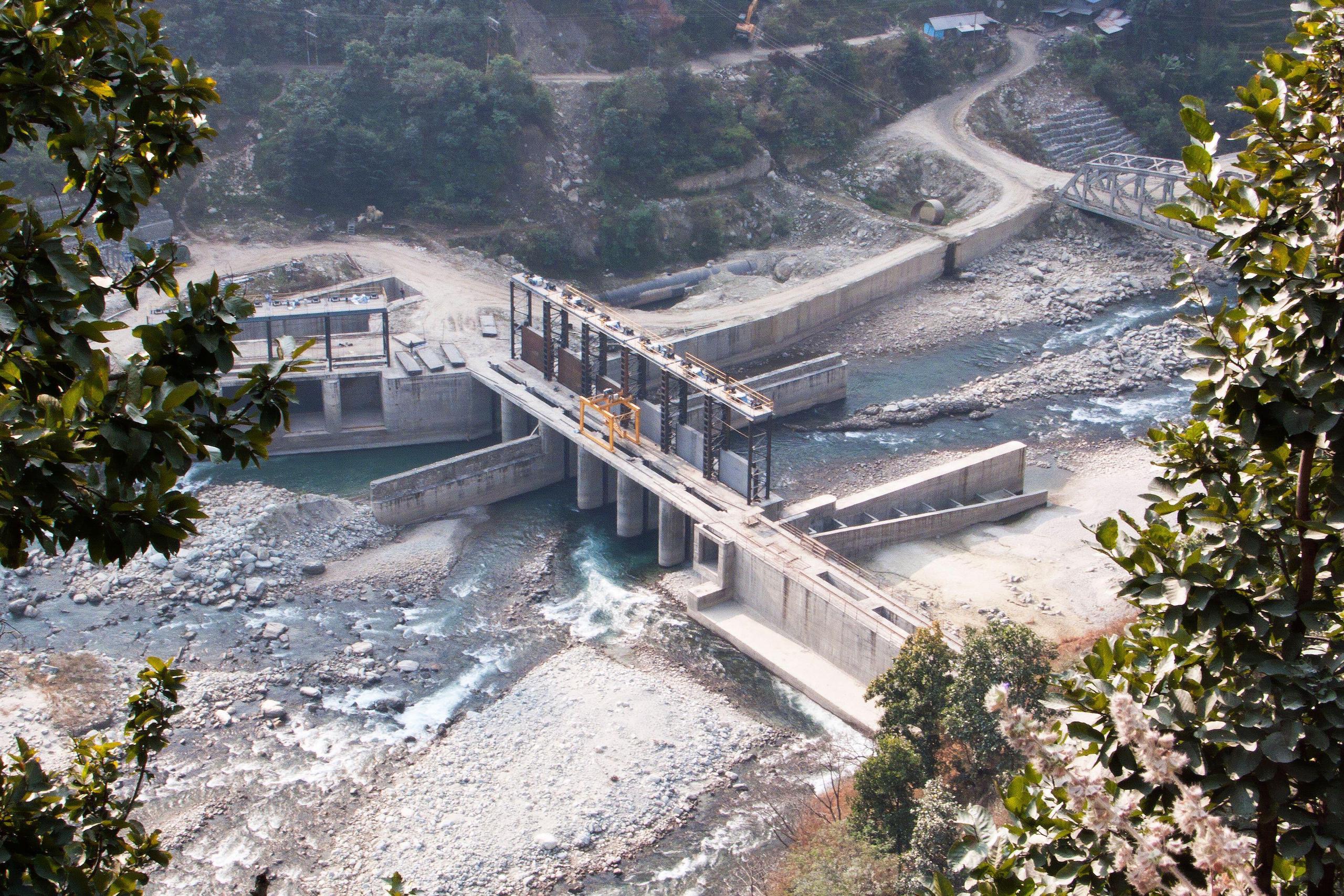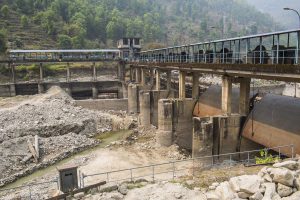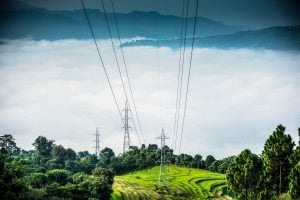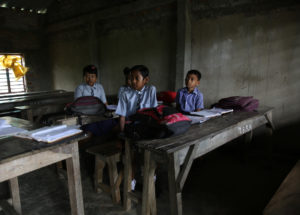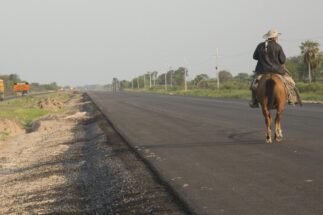In recent years, Nepal has started to shift hydropower projects worth billions of dollars from Chinese developers to Indian companies. This is happening, experts say, not for economic or ecological reasons – two areas where Nepal’s ambitious pursuit of hydropower has been criticised – but because India, as Nepal’s principal buyer of the exported electricity, apparently refuses to buy power produced by Chinese-built plants.
The story of the 750-megawatt West Seti hydropower project in western Nepal shows how geopolitics is steering this shift. In 2012, Nepal signed a memorandum of understanding with the China Three Gorges Corporation to develop the project, one of the largest planned in the country at an estimated cost of USD 1.2 billion. This was followed by a 2017 deal to set up a billion-dollar joint venture company. In 2018, however, the Chinese company backed out, citing lower-than-expected returns, and geographic and other development challenges.
10,000 MW
Installed hydropower capacity the Nepal Electricity Authority hopes to achieve by 2030, from 2,190 MW as of 2021
According to the Investment Board Nepal (IBN), the government agency responsible for promoting and facilitating domestic and foreign investment in the country, the Chinese company had asked to downsize the project from 750 MW to 600 MW, arguing that the larger amount was not economically viable. “Nepal’s government agreed to the terms and asked for documents to proceed to start the project but the company didn’t submit required documents,” reads a report prepared by IBN for other government agencies.
A different reason was given by Sher Bahadur Deuba, the prime minister of Nepal and chair of IBN. “India won’t buy electricity from the West Seti hydro project if it’s built by Chinese companies so I am going to give it to India,” Deuba told the media in May 2022 while campaigning for local elections.
It’s not the time to celebrate but to look at how badly the agreement was done, as it doesn’t talk about sharing of water resources between two countriesDipak Gyawali, Nepal’s former minister of water resources
The following month, the IBN decided to award the West Seti project to India’s state-owned National Hydro Power Company (NHPC), with an agreement signed in August. In a press release, Deuba said: “We will be able to reduce the trade deficit with India by selling electricity and this will help foster better cooperation and mutual sharing of water resources between two countries.”
Another project downriver of West Seti, Seti River-6, was included in this agreement. The total cost of the two projects is now estimated at USD 2.4 billion, although IBN was, when this article was published, yet to upload documents with details about the projects to its website.
‘Geopolitical games’ hamper hydropower development
During a ceremony in August to mark the signing of the agreement, NHPC’s president AK Singh said: “It is our history that when we enter a project, we complete it. We understand that West Seti is taken as a harbinger of development. We will not leave any stone unturned.”
This is not how this turn of events is perceived by everyone. “There is a strong sense of feeling in Nepal that India promises but doesn’t stand by its promises and we need to deal with it quickly,” said Ranjit Rae, India’s former ambassador to Nepal, during a webinar in August hosted by the Institute of Chinese Studies – a thinktank funded by the Indian government. This year, there have been reports of problems with the 900 MW Upper Karnali and Arun III projects being built by Indian companies in Nepal, with deadlines extended and local protests over compensation for relocation.
Dipak Gyawali, Nepal’s former minister of water resources, told The Third Pole that the West Seti deal is a loss to Nepal. “Signing an agreement doesn’t ensure project development, as it has been going on for years. It’s not the time to celebrate but to look at how badly the agreement was done as it doesn’t talk about sharing of water resources between two countries,” Gyawali said, explaining that the project will increase the flow of water to India during winter and help irrigate land there, “but there is nothing in return that Nepal is going to receive”.
We can clearly see more geopolitical games being played in Nepal’s hydropower in recent years and it will eventually hamper project developmentDwarika Nath Dhungel, former secretary of Nepal’s Ministry of Energy, Water Resources and Irrigation
The story of Nepal’s largest planned hydroelectric plant, the 1,200 MW Budhi Gandaki project, is even more complicated. It was supposed to have started generating electricity this year, but construction work has not yet started. In 2017, a few days before leaving office, the cabinet of the Communist Party of Nepal (Maoist Centre) and prime minister Pushpa Kamal Dahal decided to award the project to the China Gezhouba Group Corporation, without a bidding process. Later that year, the incoming Nepali Congress party-led government headed by Sher Bahadur Deuba scrapped the contract, citing irregularities and lack of transparency around its award.
A court action followed. Then, in February 2018, another government came to power in Nepal, with KP Oli as prime minister heading a coalition of Communist parties. This returned the project to the China Gezhouba Group Corporation in September 2018. In July 2021, Sher Bahadur Deuba returned as prime minister; on 7 April 2022 his government decided to revoke the Chinese company’s licence for the Budhi Gandaki project. The decision was made after an announcement in April of a commitment between Nepal and India to expand cooperation in the power and energy sector.
“We can clearly see more geopolitical games being played in Nepal’s hydropower in recent years and it will eventually hamper project development,” said Dwarika Nath Dhungel, former secretary of Nepal’s Ministry of Energy, Water Resources and Irrigation.
Indian rules exclude Chinese companies from Nepal hydropower
As governments changed in Nepal, India altered its rules regarding the purchase of power.
In 2016, India introduced an export-import guideline stating that it would buy electricity from companies that are either fully Indian-owned or are at least 51% owned by Indian companies. After complaints and lobbying by Nepal, India amended the guideline in 2018 and removed the 51% provision, but still there is a caveat. The procedure document reads: “Indian entities may import electricity provided that the generating company is not owned, directly or indirectly by any natural/ legal personality(ies) whose effective control or source of funds or residence of beneficial owner, is situated in/ citizen of a third country with whom India shares land border and that third country does not have a bilateral agreement on power sector cooperation with India.”
Though China is not mentioned explicitly, in effect this excludes China. “We have heard from Indian officials that they won’t buy electricity from companies that have Chinese investment. Furthermore, they won’t buy electricity from those companies using Chinese equipment to produce electricity,” said Ganesh Karki, vice-president of the Independent Power Producers’ Association of Nepal (IPPAN).
India buys electricity only from those projects that don’t have Chinese investment, but still it’s better than no tradeOfficial at the Ministry of Energy, Water Resources and Irrigation
“India buys electricity only from those projects that don’t have Chinese investment, but still it’s better than no trade,” said an official at the Ministry of Energy, Water Resources and Irrigation, speaking on the condition of anonymity.
“I don’t see a situation where India can encourage Chinese investment in Nepal’s hydropower as India itself has enough capacity and resources to develop hydro projects in Nepal,” said Rae, India’s former ambassador to Nepal. “It’s evolving though. We had said it was India and Nepal only earlier but now India has been flexible to multilateral investments but not China.”
Some experts believe this side-lining of China will harden, especially in hydropower development. “It’s a double standard of India as it has been welcoming investment from [China] to its territory but discouraging [Chinese] investment to its neighbour,” said Anup Kumar Upadhyay, former water resources secretary at Nepal’s Ministry of Energy, Water Resources, and Irrigation. He added: “Fighting on such a large battlefield with such a weak weapon won’t help [India] achieve anything.”
Others emphasise that this is not just about investment, but is a strategic matter for India. “China sees Nepal’s water resources through the lens of development and it is a money-making business for them. But for India, it’s a strategic resource and is an issue of security so water is far more important to them,” said former water resources minister Gyawali.
He added: “Sadly Nepal doesn’t have its own lens – neither [a] development lens nor a security [lens]. It is lost somewhere and that is an even bigger problem.” Moreover, with development and security the only lenses through which hydropower is looked at, other important issues such as ecological impact or whether projects make economic sense are ignored.
Nepal’s electricity-exporting plans
These issues have become more important relatively recently, with India only opening its market to Nepal’s electricity in November 2021. According to Nepal’s Ministry of Energy, Water Resources and Irrigation, India had agreed to buy 39 MW produced by two hydropower projects – the 24 MW Trishuli and 15 MW Devighat plants, both developed by India. In June 2022, it increased the amount to 364 MW.
Nepal added 710 MW of hydropower to its national grid in 2021, giving the country an energy surplus for the first time and expanding its installed hydropower capacity to 2,190 MW, according to the Nepal Electricity Authority. This is still far from the government’s stated aim of creating 10,000 MW of installed capacity by 2026. The Nepal Electricity Authority hopes to now achieve this by 2030, through power purchase agreements for 4,839 MW with private companies and producing 4,341 MW itself.
Nepal doesn’t have its own lens – neither a development lens nor a security lens. It is lost somewhere.Dipak Gyawali, Nepal’s former minister of water resources
In a June press release, the managing director of the Nepal Electricity Authority, Kul Man Ghising, stated that “the quantity of electricity sold in June and earnings [USD 13 million] made from it suggest trading of electricity with India has been moving forward smoothly”. He also voiced an ambition to transmit electricity through India to its neighbours: “In addition to India, we will sell at least 100 MW electricity to Bangladesh soon and works are in progress. It will happen in next one year.”
Just as long as that electricity does not come from Chinese-built projects, or those using Chinese equipment.
